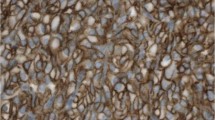Summary
According to the earlier concept, the paraganglia of man are believed to degenerate during the first postnatal years after their dominance during the fetal period. Clinical case reports on persisting paraganglia led us to extensive exploration of surgical material obtained from urological and gynecological surgery. The formaldehyde induced fluorescence (FIF) was used for tracing the catecholamine containing tissues. The fluorescence intensities were recorded with a Lietz MPV 2 microspectrophotometer.
Solitary, small paraganglia were found in all patients studied. They were expecially frequent in the walls of the urinary bladder and in the connective tissue surrounding the urogenital organs. The intensity of the fluorescence was comparable to pharmacological standard of 10−2 M noradrenaline and at the same level as the FIF of human fetal paraganglia. All cells of the paraganglionic clusters exhibited FIF and no signs of degeneration could be observed.
It is suggested that the paraganglia of man do not degenerate postnatally but persist as a remarcable catecholamine reservoir, which might be of physiological importance.
Similar content being viewed by others
References
Brundin, T.: Studies on the preaortal paraganglia or newborn rabbits. Acta physiol. scand. 70, Suppl. 290 (1966)
Burnstock, G., Costa, M.: Adrenergic neurons. Their organization function and development in the peripheral nervous system. London: Chapman & Hall (1975)
Coupland, R.E.: The natural history of the chromaffin cell, London: Longman's 1965
Doctor, V.M., Phadke, A.G., Sirsat, M.V.: Pheochromocytoma of the urinary bladder. Brit. J. Urol. 44, 351–353 (1972)
Elfvin, L.-C.: A new granule-containing nerve cell in the interferior mesenteric ganglion of the rabbit. J. Ultrastruct. Res. 22, 37–41 (1968)
Eränkö, O.: The practical histochemical of catecholamines by formaldehyde-induced fluorescence. J. roy. micr. Soc. 87, 259–276 (1967)
Eränkö, O., Härkönen, M.: Monoamine containing small cells in the superior cervical ganglion of the rat and an organ composed of them. Acta physiol. scand. 63, 511–512 (1965)
Fuselier, H.: Paraganglioma of the bladder: Report of a case. J. Urol. (Baltimore) 113, 42–44 (1975)
Hervonen, A.: Development of catecholamine-storing cells in the human fetal paraganglia and adrenal medulla. Acta physiol. scand. Suppl. 368, 1 (1971)
Hervonen, A., Korkala, O.: Histochemically demonstrable monoamines of human fetal carotid body. Experientia (Basel) 28, 449–450 (1972)
Kanerva, L.: Development, histochemistry and connections of the paracervical (Frankenhäuser) ganglion of the rat uterus. Acta Inst. Anat. Univ. Helsinki, Suppl. 2 (1972)
Kanerva, L., Hervonen, A.: SIF-cells, short adrenergic neurons and vacuolated nerve cells of the paracervical (Frankenhäuser) ganglion. In: Symposium on SIF-cells, Fogarty International Center, N.I.H., Government Printing Office Ed. O. Eränkö. 19–34 (1976)
Kanerva, L., Hervonen, A., Hervonen, H.: Morphological characteristics of the ontogenesis of the mammalian peripheral adrenergic nervous system with special remarks on the human fetus. Med. Biol. 52, 144–158 (1974)
Kohn, A.: Die Paraganglien Arch. mikr. Anat. 62, 263–365 (1903)
Korkala, O., Hervonen, A.: Origin and development of the catecholamine-storing cells of the human fetal carotid body. Histochemie 37, 287–297 (1973)
Kuo, T., Anderson, C.B., Rosai, J.: Normal paraganglia in the human gall-bladder. Arch. Path. 97, 46–47 (1974)
Leestma, J.E., Pride, E.B.: Paraganglioma of the urinary bladder. Cancer (Philad.) 28, 1963–1968 (1971)
Lempinen, M.: Extra-adrenal chromaffin tissue of the rat and the effect of cortical hormones on it. Acta physiol. scand. 62, Suppl. 231 (1964)
Mascorro, J.A., Yates, R.D.: A review of abdominal paraganglia: Ultrastructure, mitotic cells, catecholamine release, innervation, light and dark cells, vascularity. In: Electron microscopic concepts of secretion. Ultrastructure of endocrinal and reproductive organs. (M. Hess, ed.). London-New York: John Wiley & Sons Inc. 1975
Matthews, M.R., Raisman, G.: The ultrastructure and somatic efferent synapses of small granulecontaining cells in the superior cervical ganglion. J. Anat. (Lond.) 105, 255–282 (1969)
Olson, J.R., Abell, M.R.: Nonfunctional, nonchromaffin, paragangliomas of the retroperitoneum. Cancer (Philad.) 23, 1358–1367 (1969)
Scott, W.W., Eversole, S.L.: Pheochromocytoma of the urinary bladder. J. Urol. (Baltimore) 83, 656–662 (1960)
Silver, J., Thomas, D., Young, R., Dowling, R.H.: Paeochomocytoma of the bladder. Proc. roy. Soc. Med. 64, 670–677 (1971)
Zimmerman, I.J., Biron, R.E., MacMahon, H.E.: Pheochremocytoma of the urinary bladder. New Engl. J. Med. 249, 25–27 (1953)
Zuckerkandl, E.: Über Nebenorgane des Sympaticus im Retroperitonealraum des Menschen. Anat. Anz. 15, 97–197 (1901)
Author information
Authors and Affiliations
Rights and permissions
About this article
Cite this article
Hervonen, A., Vaalasti, A., Vaalasti, T. et al. Paraganglia in the urogenital tract of man. Histochemistry 48, 307–313 (1976). https://doi.org/10.1007/BF00499247
Received:
Issue Date:
DOI: https://doi.org/10.1007/BF00499247




